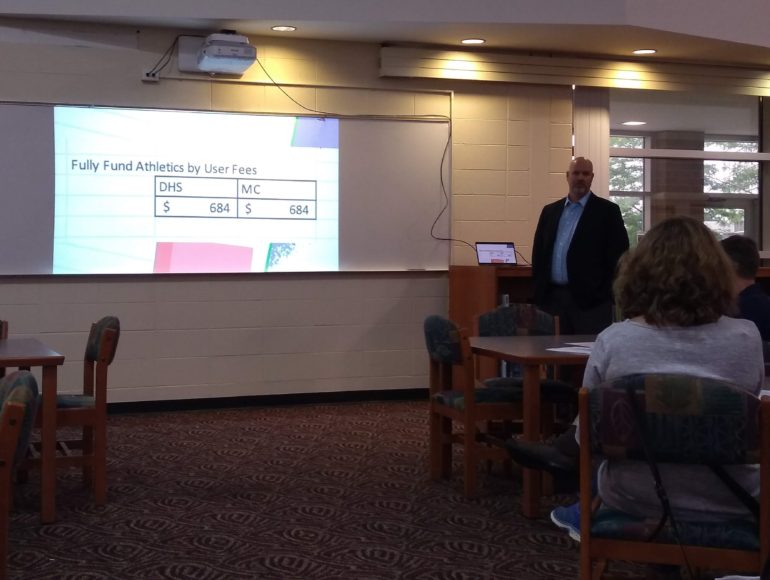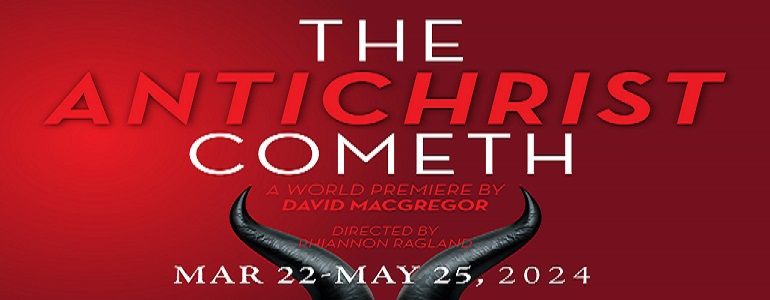On Tuesday, Sept. 10, Superintendent Chris Timmis led a much-anticipated community forum regarding the Board of Education’s discussion of pay-to-participate athletics. The BOE paused discussion of the topic in July on recommendation of the both the Ad Hoc Athletics and Finance committees. Tuesday’s meeting was the first of two community forums to be held to gather stakeholder feedback.
Around 20 community members, including Dexter parents and BOE trustees attended the meeting held in the DHS media center. Athletic Director Mike Bavineau and Dexter CFO Dr. Sharon Raschke were present to take notes, clarify budget numbers and answer audience questions.
How We Arrived at Today
Dr. Timmis began the presentation by recapping the history of the pay-to-participate athletics topic and its evolution into this meeting. In early 2018, the Board of Education created the Ad Hoc Athletics Committee with a dual purpose: 1) To review and make recommendations to the BOE regarding DCS offerings and the structure of funded, self-funded and club-funded sports, and 2) to review and make recommendations to the BOE regarding a financially sustainable and Title IX-compliant Districtwide K-12 athletic program.
Delving into these topics, the committee soon recognized an equity problem in Dexter athletics based on school- vs. self-funded sports, the timing of the sport (fall/winter/spring) and male vs. female sports. Dr. Timmis gave this example scenario:
A male HS student plays water polo (a self-funded sport) in the fall, so he does not pay the 1st sport pay-to-participate fee. If that male student then swims in the winter (a school-funded sport), he receives credit for playing that 1st sport in the fall, and subsequently pays the 2nd sport pay-to-participate fee of $150 for swimming.
Conversely, a female HS student swims (school-funded) in the fall, paying the 1st sport pay-to-participate fee of $250. If that female student then plays water polo (self-funded) in the spring, she does not pay a 2nd sport pay-to-participate fee.
Because of the timing of each sport, the female student is paying $250 to swim while the male student is only paying $150 for the same sport. The issue facing the Ad Hoc Athletics committee is that these two students are participating in the same sport, but paying unequal fees.
The Ad Hoc committee has since discussed multiple scenarios of pay-to-participate options in order to correct this inequality, settling on a flat fee of $250 per sport. The committee recommended this proposal to the BOE Finance Committee, which in turn recommended it to the full BOE. After much dialogue, it was determined that stakeholder input was needed to move forward.
The Numbers
Prior to opening the meeting, Dr. Timmis ensured all attendees received a copy of the PowerPoint presentation and an 11×17 spreadsheet summary of the Athletic Program budget numbers from 1977 to the present, including the 2019-2020 projected budget. He began his remarks with an infographic created by E4DS detailing how Dexter Schools receive funding. Dexter currently receives $8,117 per pupil from the state, and DCS must collect at least 18 mills from non-homestead properties in order to receive that full amount; any less, and the state will reduce Dexter’s funding. There is also some inequity in the state funding system: Ann Arbor receives approximately $1,300 more per pupil and Bloomfield Hills approximately $4,100 more per pupil. In short, DCS receives whatever the state dictates for public funding.
Turning specifically to the Athletics budget, Dr. Timmis shared that the total cost of school-funded athletics in 2018-2019 was $928,072. Athletics brought in $304,044 in revenue last year, which means that DCS offset the Athletics budget by $624,029 from the General Fund (1.6% of the total DCS budget). Put a different way, of the $8,117 per pupil state funding, $170 per each K-12 student was spent on Athletics in 2018-2019.
Dexter currently has two types of teams – school-funded and self-funded. Around 2000, a group of high school students proposed that Dexter have a hockey team, one of the most expensive high school sports. It was agreed that Dexter could have a team, but it would have to be self-funded. Other sports soon followed, including lacrosse, field hockey and equestrian among others.
The majority of Dexter teams are school-funded, which means they fall under the pay-to-participate fee structure. From these collected fees (as well as gate admissions, donations and state funding) the District pays for coaches (30%), officials/trainers (21%), transportation (16%), administrative costs (25%) and other (8%).
Looking at the Athletics budget numbers all the way back to 1977, expenses have always outweighed revenues and the District has subsidized Athletics to some extent. The subsidy has ranged from 0.8% – 2.4% in the past 30 years, and is currently around 1.6.% of the total budget. When the subsidization reached its highest point in the early 90’s, pay-to-participate was implemented to lower costs to the District. On average, the Athletics budget has consistently received around 1.5-2% subsidy from the General Fund since 1977.
Approximately 36% of the total $928,072 Athletics budget is the administrative overhead cost of $333,906, which includes AD office salaries, strength trainers and department-wide costs necessary to run all sports teams under the Athletics umbrella. Dividing that number across the current 28 teams (both school- and -self-funded, as all teams need administrative support), the administrative cost per sport comes to $11,925.21.
Based on these current budget numbers, if DCS wanted to fully fund Athletics using only pay-to-participate fees with no General Fund subsidies, it would cost families $684 per student per sport (both high school and middles school). Dr. Timmis presented a series of flat-fee pay-to-participate scenarios showing the break-even points for each scenario. If the District charged both high school and middle school athletes the same fee per sport, the break-even point is between $175-200. Looking at high school sports alone, the break-even is just shy of $225 per sport, and middle school sports alone is around $125 per sport. These break-even numbers are not far off from the current pay-to-participate fees charged for school-funded sports.
Timmis ended his remarks with the reminder that the original issue under discussion was to solve the equity problem caused by the current graduated pay-to-participate fee system. “In the end, we still have to look at what is the right amount to spend on athletics and what is the right amount to charge. That’s where we are now.”











